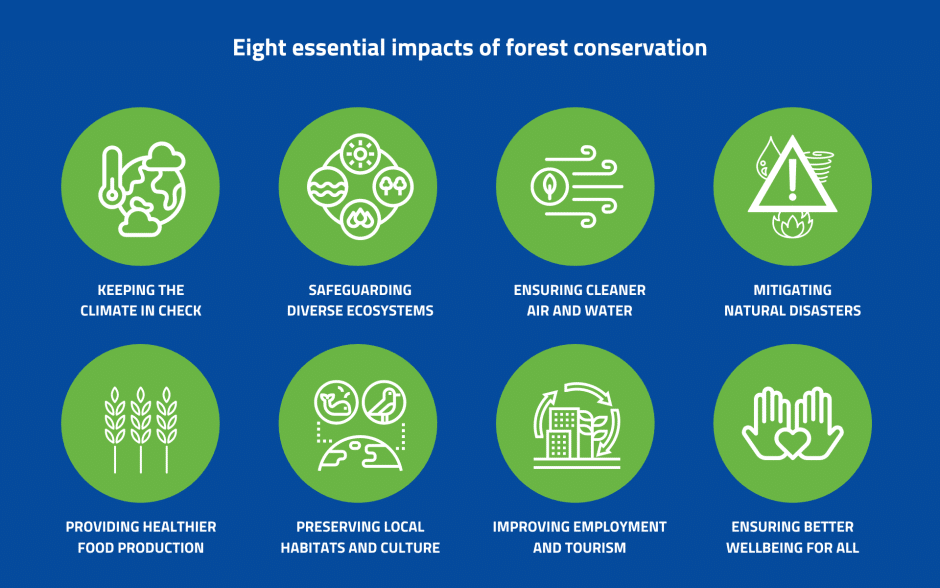Getting the best from our forests: Five ways to manage them well
Opinion
25 Mar 2024
In our urgent fight against climate change and loss of biodiversity, managing forests sustainably has become a key strategy for protecting the environment and regulating ecosystems. We know that forests, often called the lungs of the Earth, play a key role in keeping our climate in check by absorbing carbon dioxide and releasing oxygen. But they do more than that – they’re also essential for effective land management and agriculture.
Yet we’re not always harnessing their full potential. Despite extensive investments in research, it still remains a challenge to turn the knowledge of effective forest management into practical action that make sense to actors in the sector, policy makers and citizens. This gap between knowing and doing shows how important it is to involve all affected parties in shaping strategies for sustainable forest management and land use. This not only helps people understand and find policy recommendations more relevant, but it also makes them more willing to accept change.
Here’s the thing – forest management impacts more than just those directly involved in forestry or environmental advocacy. It concerns everyone. Even if you’ve never set foot in a forest, the way they are managed affects your daily life. The choices we make about forests influence the food we eat, the air we breathe, the places we live and work, and a myriad of other human activities.

So, how can we boost sustainable forest management and create more resilient land use for us and future generations? How can we enhance collaboration among diverse stakeholders to achieve these objectives effectively?
1- Foster and strengthen connections among actors. Collaboration sparks innovation, and by uniting foresters, policymakers and citizens, we can pioneer inventive solutions that bring everyone on board. Systems mapping is crucial: identifying key players and understanding their primary interests, interactions and individual challenges is paramount. This guiding principle informs our holistic strategy at EIT Climate-KIC, for example as seen in our INFORMA project working on forest management for climate mitigation, where through our ‘challenge-led system mapping’ we foster collaboration among industry, academia, civil society, and policymakers – stakeholders that often work in silos – to address the complexities of the European forest system. By collectively understanding stakeholders’ interests, we aim to pioneer new approaches for sustainable forest management, promoting environmental stewardship and resilience.

Example of an international knowledge mapping network, specifically on how knowledge is shared between actors. This figure was generated during the first workshop of the INFORMA project, hosted by EIT Climate-KIC.
2 – Maximise the potential of existing forests. Instead of fixating solely on expansion, it’s important to efficiently make use of our current forested areas. This involves implementing adaptive strategies that address the evolving landscape and confront the impacts of climate change, including fires, storms, pests, and diseases.
3 – Embrace science-driven methodologies. Robust scientific insights are essential. That’s why projects like INFORMA are conducting satellite research, data mining, and climate modelling to craft comprehensive best practices for sustainable forest management across Europe, that can be used as examples for all. It’s only by harnessing the power of science that we can make well-informed decisions that safeguard our forests for generations to come.
4 – Translate knowledge into actionable policies. Simple accumulation of scientific data falls short: there is an urgent need translate this into policies that drive tangible change, for example by transforming scientific findings into policy recommendations for national and regional governments. This then feeds into policies that can, for example, improve the effectiveness of carbon certification schemes and ensure that our forest management practices align with global climate change goals.
5 – Educate and empower. Awareness serves as the catalyst for transformation. By educating the public about the significance of sustainable forest management and involving citizens in decision-making processes, we can nurture a collective dedication to safeguarding our forests. Whether through grassroots initiatives or governmental policies, each initiative contributes to the preservation of our natural resources.
Implementing these steps represents a significant leap forward in advancing sustainable forest management. Forests transcend trees; they are intricately linked to all facets of our existence. By embracing these principles and executing tangible strategies, we can chart a path towards a future where forests prosper, ecosystems thrive, and humanity lives in harmony with nature.
Find out more about our work in sustainable forest management here.



